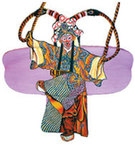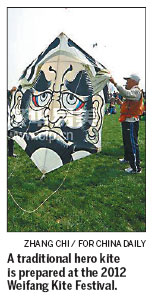
Related: High FLyers, Stringing past with future
Legend has it that about 2,500 years ago, a famous philosopher, Mozi, who lived in Weifang, spent three years making a wooden bird that could fly. That was the earliest kite in history, way before Leonardo da Vinci made a similar experiment in 1485.
Later, a renowned carpenter, Lu Ban, introduced bamboo frames to make the contraptions lighter and easier to fly up in the air.
With the invention of paper in the Eastern Han (AD 25-220) period, much lighter kites became possible.
At first, kites were used to gather and send military intelligence and were also used as communication and meteorological tools.
During the Tang Dynasty (AD 618-907), flying kites became a recreation and people began tying bamboo whistles to kites. Flying in the wind, the bamboo whistle was imagined to be singing like a zheng, a stringed instrument similar to a zither, giving kites the name feng zheng (whistle in the wind).
Soon Chinese kites traveled out of the country and by the end of the 13th century, Italian traveler Marco Polo introduced stories about Chinese kites to Europe.
Flying kites is a favorite pastime in today's China, a popular form of exercise, especially in spring. It is also a way of giving free rein to one's wishes and hopes for the future. The images and writing on kites are meant to usher in blessings, happiness and longevity.

Kite Styles

Bunch: It is made up of several kites that are connected to each other by strings. The dragon-headed centipede kite is a typical example.
Hard-winged: The wing-shaped frame is formed by two horizontally placed bamboo strips, leaving a part in the middle for wind to pass through. Often the image is an illustration of a scene or figure from mythology or history.
Soft-winged: The frame, made of thin, malleable bamboo strips, is soft - suitable for making bird- or insect-shaped kites.
Plank-shaped: This is a flat-framed structure. A long tassel is usually attached to the lower part of the kite for balance. Since it is easier to make and fly, the plank-shaped kite is most common.
Barrel-shaped: Also called a three-dimensional kite, the "barrel" frame is typically used to form a lantern or flower vase.
Free-style: It features different types of frame structures, usually made using newer materials and techniques, such as the 108 heroes kites inspired by the classical work The Water Margin, and the luminous kite.